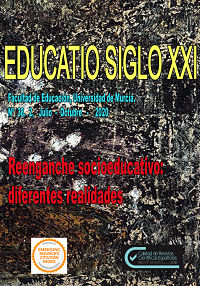Evolution and new perspectives of the concept of resilience: from an individual-based approach to socio-educational contexts and relationships
Abstract
Resilience is a concept that in recent years has had an ever-increasing presence in social and educational settings in Spain. Although its use is relatively recent in the Spanish context, it has been used in professional practice and supported by extensive research in the English-speaking context. This paper aims to study the evolution of this concept over the last decades. Our analysis found that resilience is a controversial topic and is still being constructed. The outcomes of the literature review and the conceptual study on resilience showed that this issue has been evolving over the last three decades, moving from an individual-based approach to resilience, focused on the qualities of a resilient person, towards a more socio-educational focus, concerned with understanding all the cultural and community-based elements that emerge and interact in resilience processes. From this analysis, the paper delimits some conclusions aimed at rethinking and updating how resilience practices and research are addressed.
Downloads
-
Abstract7941
-
PDF (Español (España))10244
References
Allan, R. y Ungar, M. (2014). Developing a measure of fidelity for an ecological approach to family therapy. Journal of Family Psychotherapy, 25(1), 26-41.
Anthony, E.J. (1974). Introduction: The syndrome of the psychologically vulnerable child. In Anthony, E.J. y Koupernik, C. (Ed.), The child in his family: Children at Psychiatric Risk. Vol. 3. New York: Wiley, 3-10.
Arnaiz, P. (2012). Escuelas eficaces e inclusivas cómo favorecer su desarrollo. Educatio Siglo XXI, 30 (1), 25-44.
Becvar, D. S. (Ed.). (2012). Handbook of family resilience. New York: Springer Science y Business Media.
Benson, P. L. (1997). All kids are our kids: What communities must do to raise caring and responsible children and adolescents. San Francisco: Jossey-Bass.
Bermejo, J.C. (2007). La relación de ayuda en el ámbito educativo. Santander: Sal Terrae.
Bronfenbrenner, U. (1987). La ecología del desarrollo humano: experimentos en entornos naturales y diseñados. Barcelona: Paidós.
Bruner, J. (1997). La educación, puerta de la cultura. Madrid: Visor.
Castillejo, J.L. (1994). La educación como fenómeno, proceso y resultado, en AAVV, Teoría de la Educación. Madrid: Taurus. 15-28.
Civís, M. y Longás, J. (2015). La colaboración interinstitucional como respuesta al desafío de la inclusión socioeducativa. Análisis de 4 experiencias de trabajo en red a nivel local en Cataluña. Educación XX1, 18(1), 213-236.
Clarke, A. y Clarke, A. (2000). Early Experience and the Life Path. London: Jessica Kingsley.
Costa, S., Forés, A. y Burguet, M. (2014). Els tutors de resiliencia en l’educació social. Temps d’Educació, 46, 91-106.
Cyrulnik, B. (2002). Los patitos feos. La resiliencia: una infancia infeliz no determina la vida. Barcelona: Gedisa.
Cyrulnik, B. (Comp.) (2004). El realismo de la esperanza. Testimonios de experiencias profesionales en torno a la resiliencia. Barcelona: Gedisa.
Daniel, B. (2006). Operationalizing the concept of resilience in child neglect: case study research. Child: Care, Health and Development, 32(3), 303-309.
Daniel, B. (2010). Concepts of adversity, risk, vulnerability and Resilience: A discussion in the context of the ‘Child Protection System’. Social Policy and Society, 9(2), 231-241.
Dugan, T. y Coles, R. (1989). The child our times. New York: Brunner.
Esteve, J.M. (1983). El concepto de educación y su red nomológica, en AAVV, Teoría de la Educación. Murcia: Límites. 11-25.
Esteve, J. M., Ruiz, C. y Rascón, M. T. (2008). La construcción de identidad en los hijos de inmigrantes marroquíes. Revista Española de Pedagogía, 241, 489-508.
Fiorentino, M. T. (2008). Construcción de la resiliencia en el mejoramiento de la calidad de vida y la salud. Suma Psicológica, 15(1), 95-114.
Forés, A. y Grané, J. (2008). La resiliencia: Crecer desde la adversidad. Barcelona: Plataforma Actual.
Garmezy, N. y Rutter, M. (1983). Stress, coping, and development in children. New York: McGraw-Hill.
Garmezy, N., Masten, A. S. y Tellegen, A. (1984). The study of stress and competence in children: A building block for developmental psychopathology. Child Development, 55, 97-111.
Geertz, C. (1990). La interpretación de las culturas. Barcelona: Gedisa.
Gilligan, R. (1997). Beyond Permanence? The importance of resilience in child placement practice and planning. Adoption and Fostering, 21(1), 12–20
Gómez, E. y Kotliarenco, M. A. (2010). Resiliencia Familiar: Un enfoque de investigación e intervención con familias multiproblemáticas. Revista de Psicología, 19(2), 103-132.
Gore, S. y Eckenrode, J. (1994). Context and process in research on risk and resilience, in: R. Haggerty et al. (Eds) Stress, Risk and Resilience in Children and Adolescents: Processes, Mechanisms and Interventions. New York: Cambridge University Press.
Hart, A. y Heaver, B. (2013). Evaluating resilience-based programs for schools using a systematic consultative review. Journal of Child and Youth Development, 1(1), 27-53.
Heller, S.S., Larrieu, J.A., D’Imperio, R. y Boris, N.W. (1999). Research on resilience to child to child maltreatment. Abuse and Neglect, 23, 321–338.
Jollien, A. (2000). Eloge de la faiblesse. Paris: Le Cerf.
Khan, M. (1964). The concept of cumulative trauma. Psychoanalytical Study of the Child. New York: International Universities Press.
Lewis, J. (1999). Research into the concept of resilience as a basis for the curriculum for children with EBD. Emotional and behavioural difficulties, 4(2), 11-22.
Luthar, S.S. (2003). Resilience and Vulnerability. New York: Cambridge University Press
Madariaga, J.M. (2014). Nuevas miradas sobre la resiliencia: ampliando ámbitos y prácticas. Barcelona: Gedisa.
Manciaux, M. (Comp.) (2010). La resiliencia: resistir y rehacerse. Barcelona: Gedisa.
Masten, A.S. (2001). Ordinary magic: resilience processes in development. American Psychologist, 56(3), 227–238.
Masten, A. y Obradovic, J. (2006). Competence and resilience in development. Annals of the New York Academy of Sciences, 1094(1), 13-27.
Newman, T. y Blackburn, S. (2002). Transitions in the Lives of Children and Young People: Resilience Factors. Edinburgh: Scottish Executive.
Palmer, N. (1997). Resilience in adult children of alcoholics: A nonpathological approach to social work practice. Health y Social Work, 22(3), 201-209.
Raphael, B. (1993). Adolescent resilience: the potential impact of personal development in schools. Journal of paediatrics and child health, 29(s1), S31-S36.
Rayner, M., y Montague, M. (2000). Resilient children and young people. Melbourne, Vic.: Deakin University, Policy and Practice Unit.
Rigsby, L. C. (1994). The Americanization of resilience: deconstructing research practice, in M. C. Wangand E. W. Gordons (eds.) Educational Resilience in Inner-City America: Challenges and Prospects. NJ: Lawrence Erlbaum.
Rubio, J.L. y Puig, G. (2015). Tutores de Resiliencia. Barcelona: Gedisa.
Ruiz-Román, C., Calderón, I. y Torres, F. J. (2014). Construir la identidad en los márgenes de la globalización: educación, participación y aprendizaje. Cultura y Educación, 23(4), 589-599.
Ruiz-Román, C., Calderón, I. y Juárez, J. (2016). (En prensa): La resiliencia como forma de resistir a la exclusion social: un análisis comparativo de casos. Pedagogía Social. Revista Interuniversitaria.
Rutter, M. (1979). Protective factors in children's responses to stress and disadvantage. In M.W. Kent y J.E. Rolf (Eds.), Primary prevention in psychopathology: Social competence in children. Hanover, NH: University Press of New England.
Rutter, M. (1985). Resilience in the face of adversity: protective factors and resistance to psychiatric disorders. British Journal of Psychiatry, 147, 589 – 611.
Rutter, M. (1999). Resilience concepts and fi ndings: implications for family therapy. Journal of Family Therapy, 21, 119–160.
Sanz, J. (2002). El humor como valor terapéutico. Med Clin (Barc), 119(19), 734-737.
Smith, C., y Carlson, B. E. (1997). Stress, coping, and resilience in children and youth. The Social Service Review, 231-256.
Sobel, R. (1973). What went right? The natural history of the early traumatized, in E.G. Witenberg (ed.), Interpersonal explorations in psychoanalysis. New York: Basic.
Spaccarelli, S. y Kim, S. (1995). Resilience criteria and factors associated with resilience in sexually abused girls. Child Abuse y Neglect, 19(9), 1171-1182.
Suárez-Ojeda, N. E. y Autler, L. (2003). La resiliencia en la comunidad: un enfoque social. En E. H. Grotberg (Ed.), La resiliencia en el mundo de hoy. Cómo superar las adversidades. Barcelona: Gedisa. 271-300.
Torres, J.A. (2012). Estructuras organizativas para una escuela inclusiva: promoviendo comunidades de aprendizaje. Educatio Siglo XXI, 30 (1), 45-70.
Ungar, M. (2004). The importance of parents and other caregivers to the resilience of high-risk adolescents. Family Process, 43(1), 23-41.
Ungar, M. (2015). Practitioner Review: Diagnosing childhood resilience: A systemic approach to the diagnosis of adaptation in adverse social ecologies. Journal of Child Psychology and Psychiatry, 56(1), 4-17.
Ungar, M., Ghazinour, M., y Richter, J. (2013). What is Resilience Within the Ecology of Human Development? Journal of Child Psychology and Psychiatry, 54 (4), 348-366.
Uriarte, J. (2006). Construir la resiliencia en la escuela. Revista de Psicodidáctica, 11(1), 7-24.
Vanistendael, S. (2005). La resiliencia: Desde una inspiración hacia cambios prácticos. II Congreso Internacional de los trastornos del comportamiento en niños y adolescentes. Recuperado el 1 de noviembre de 2015 de, https://www.obelen.es/upload/262D.pdf
Vanistendael, S. y Lecomte, J. (2002). La felicidad es posible. Despertar en niños maltratados la confianza en sí mismos: construir la resiliencia. Barcelona: Gedisa.
Walsh, F. (2015). Strengthening family resilience. New York: Guilford Publications.
Werner, E. E. y Smith, R. S. (1982). Vulnerable but invincible. A longitudinal study of resilient children and youth. New York: McGrawHill.
Wolin, S. J. y Wolin, S. (1993). The resilient self. New York: Willard.
Original work publishes in this journal is subject to the following terms:
1. Murcia University Press (the publishing house) holds the copyright of the publishes work, and favours and allows their reutilization under the use license stated in point 2.
© Servicio de Publicaciones, Universidad de Murcia, 2015
2. Work is published in the electronic edition under a license (Creative Commons Reconocimiento-NoComercial-SinObraDerivada 4.0 España (legal text). They can be copied, used, disseminated, transmitted and publicly presented, as long as: i) authorship and original publication source is acknowledged (journal, publishing house and URL of the work); ii) are not used for commercial purposes; iii) the existence and specifications of this use license is stated.
3. Conditions for self-archive. Authors are allowed and encouraged to disseminate electronically the pre-pint (before review) and/or post-print (accepted for publication) versions of their work before their publication since that favours earlier circulation and dissemination resulting in an increased chance for the authors to be cited and for the work to reach a bigger share of the academic community. Colour: RoMEO: green.







